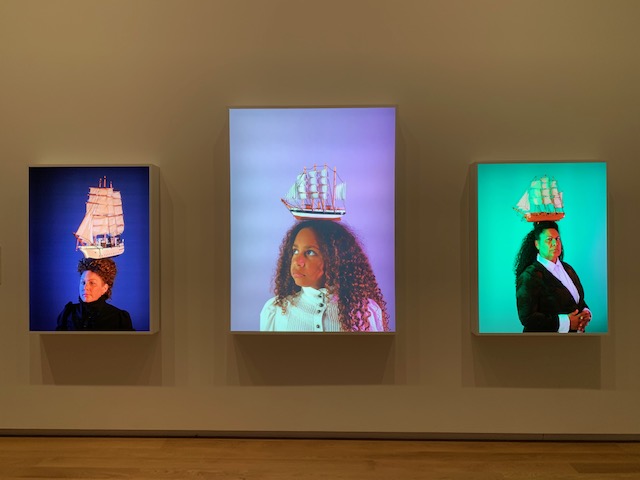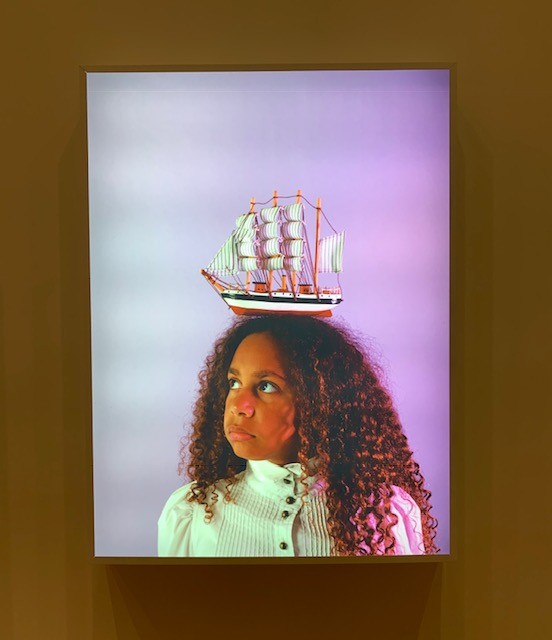History, Gender, and Power at the Auckland Art Gallery
Two artists featured at the Auckland Art Gallery in New Zealand, Pati Solomona Tyrell and Jasmine Togo-Brisby, invite and challenge visitors to engage with diversity of gender expression and the problematic history of slavery in the South Pacific.
On a recent visit to the Auckland Art Gallery in New Zealand, I was struck by the strength and clarity of two artists: Pati Solomona Tyrell and Jasmine Togo-Brisby. The works are featured in the “Chapters of Change in New Zealand Art” exhibition, which seeks to highlight the diversity and complexity of modern New Zealand art and visual culture. Walking into the first gallery, visitors immediately sense the openness of the space, facilitated by the clean, white walls and soaring ceiling height. The works of Pati Solomona Tyrell and Jasmine Togo-Brisby face each other on opposite sides of the room, as visual bookends. Jasmine Togo-Brisby’s Post-Plantation series features three photographic portraits in boldly colored lightboxes: Closed Canoe Cargo, 2018, Post-Plantation, 2017, and Bot Blo Stil, 2017.

Jasmine Togo-Brisby, Post-Plantation series, Auckland Art Gallery Toi o Tāmaki, purchased 2018.
A generational triptych, the subjects are from the same family: mother, daughter, and grand-daughter. Each woman balances a miniaturized colonial ship on their head as a compelling signpost for the history of kidnapping pacific islanders and enslaving them to work on Australian sugar and cotton plantations in the late nineteenth and early twentieth centuries, a practice given the innocuous name of “blackbirding.”
Their strong gaze and upright posture denotes the delicate balancing act the figures experience as women, pacific islanders, and descendants of oppression and colonization. Togo-Brisby’s figures stoically carry the weight of their enslaved histories but powerfully, unapologetically gaze out at the viewer. Only the middle figure, the youngest, looks off into the distance, gazing upwards towards an unknown source.

Jasmine Togo-Brisby, Post Plantation, 2017, Auckland Art Gallery Toi o Tāmaki, purchased 2018
The largest in scale, the young woman evokes the ongoing colonial legacy on younger generations and the innocence of its original victims. The work is, in one sense, autobiographical. Togo-Brisby’s great-great-grandparents were taken from Vanuatu, a South Pacific archipelago, and forced to work on an Australian sugar plantation though they were only children. The impact of the series, however, extends beyond a personal family history. It confronts a problematic colonial past of an entire region.
Across the room is Pati Solomona Tyrell’s Masculine Me Tender, a series of photographic self-portraits, each featuring the artist from the chest up against a white background, facing the viewer directly. By repeating these simple compositional elements, Tyrell allows the viewer to focus on the different gender expressions presented in each photo.

Pati Solomona Tyrell, Masculine Me Tender, 2014, Auckland Art Gallery Toi o Tāmaki, purchased 2018.
The gallery’s wall label describes how the work: “challenges viewer expectations about the reality of gender diversity. Concentrating on ideas about what gender shifts might look like, Tyrell shows us that it is possible to inhabit a non-binary gender identity."[1]
Not only a confrontational challenge, I would argue the work is also an invitation. The lack of explicit identification of which photos are masculine/male and feminine/female invites the viewer to consider a spectrum of gender expression without labels. The exposed chest also highlights Tyrell’s brown skin and Pacific heritage, an intersectional presentation made explicit by the artist’s statement that “there’s an advocacy about what it means to be young, queer and Pacific.”[2]
While Tyrell’s facial expressions are contemplative and serious, the work also conveys a sense of play, experimentation, and a celebration of brown queer bodies. There is movement, performance, and vulnerability. The piece furthest to the right exudes effortless confidence [and impressive hairography], as if Tyrell truly ‘woke up like that.’

Pati Solomona Tyrell, Masculine Me Tender, 2014, Auckland Art Gallery Toi o Tāmaki, purchased 2018.
Beyond a larger commentary on LGBT+ expression, Masculine Me Tender is also a personal look at one person’s journey through and with gender. After all, the work is titled Masculine ME Tender, which functions as both an intimate surrender and interpretive directive to viewers in the spirit of Elvis Presley’s Love Me Tender.
The pictures included in this blog post were taken by me during a visit to the gallery on February 3rd, 2019. My phone captured the reflection of Jasmine Togo-Brisby’s lightboxes on the glass surface of Tyrell’s portraits. Though unintentional, it seems a fitting summary for viewer experience; bearing the weight of a problematic past as we flip our hair towards a hopeful and more diverse future.
[1] Wall Label for Masculine Me Tender, “Chapters of Change in New Zealand Art” Auckland Art Gallery Toi o Tāmaki, Auckland, New Zealand
[2] Wall Label for Masculine Me Tender, “Chapters of Change in New Zealand Art” Auckland Art Gallery Toi o Tāmaki, Auckland, New Zealand
© Layla Seale and Leiden Arts in Society Blog, 2019. Unauthorised use and/or duplication of this material without express and written permission from this site’s author and/or owner is strictly prohibited. Excerpts and links may be used, provided that full and clear credit is given to Layla Seale and Leiden Arts in Society Blog with appropriate and specific direction to the original content.



0 Comments